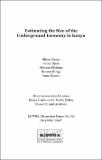Discussion Paper No. 82 of 2007 on Estimating the Size of the Underground Economy in Kenya
View/
Publication Date
2007Author
Type
Discussion Paperviews
downloads
Metadata
Show full item recordBy
Ouma, Shem ; Njeru James ; Khainga Dickson ; Kiriga Benson ; Kamau, Anne
Abstract/
The underground economy comprises economic activities not accounted for in national income statistics and is, therefore, difficult to measure. The difficulty arises because this economy comprises a host of traditional and modern; monetary and non-monetary; and legal and illegal activities. Some are invisible, hidden and illegal. Others are visible but difficult to trace, locate or identify because they are mobile and/or lack proper records. Measurement problems are also compounded by its continued evolution, adapting to changes in the policy and technology environments. However, knowledge of its size is important for policy relevance and revision; avoiding threat to revenue generation; easing tax burden on the formal sector; encouraging fair competition; exercising control for illegal activities; and expanding the tax base. Direct and indirect approaches have been used elsewhere to estimate its size. Direct approaches include: sample survey and tax audit/compliance, and indirect approaches comprise national accounting statistics, labour force statistics, transactions, currency demand, physical inputs such as electricity, and multiple indicators multiple causes (MIMIC) models.
Subject/
Economic Development; Underground Economy; Economic Challenges; Currency Demand; Market-Based Systems; Kenya
Publisher
The Kenya Institute for Public Policy Research and Analysis (KIPPRA)Series
DP/82/2007Collections
- Discussion Papers [327]

